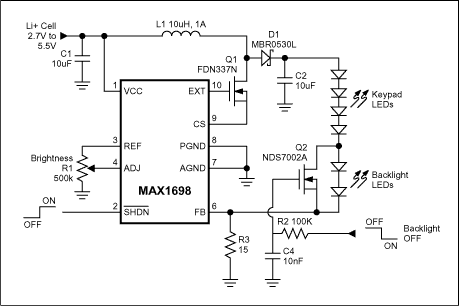A design in which the display is backlit (or frontlit) for extended periods needs an efficient circuit that drives the LEDs with a controlled current, and eliminates the wasted power associated with current-limiTIng resistors. A switch-mode boost design that regulates current instead of voltage accomplishes this purpose (Figure 1).

Figure 1. When this circuit turns off the backlight LEDs, the keypad LEDs remain on with no change in intensity.
Because all LEDs are connected in series, they all receive the same current without need for ballasTIng resistors. IdenTIcal currents help achieve uniform intensity. And because the output current is small (20mA in this case), the output filter capacitance (C2) can be smaller than for a load consisTIng of parallel-connected LEDs. The Figure 1 circuit's conversion efficiency (90%) provides a distinct power-saving advantage over resistor-limited and linearly regulated designs.
It might appear that a series-LED connection is not suitable for applications in which some (but not all) LEDs must be turned off. That capability is sometimes needed in a cell phone for which the display is off but the keypad remains lit, or in a handheld PDA that needs to play a sound file while maintaining illumination in the buttons but not the display. Actually, switching off individual LEDs or groups of LEDs is not a problem, even when all are driven in series.
Applying a logic-high level to the gate of a simple MOSFET switch (Q2) turns off a subset of LEDs (backlight LEDs in this case) by shunting their current. The remaining (keypad) LEDs remain on, and their intensity remains constant because their current is regulated by IC1, which senses the voltage across R2 (300mV at full brightness). When turning the LEDs on and off, an RC network at the gate of Q1 (R2, C4) slows the load changes sufficiently to prevent transient changes in the LED drive current. Other features include adjustable intensity via the ADJ pin, and full shutdown via the SHDN-bar logic input.
A similar version of this article appeared in the April 12, 2001 issue of EDN magazine.
What`s the main features appear into your mind when you look yoga laptop? Lightweight, super thinner, touch screen, 360 rotating, smaller size, like as notebook? You are right, that`s the main reasons why some people also called it as laptop yoga slim or yoga notebook. To OS, just same as Education Laptop-windows operating system, so you can see many windows yoga laptop at the market around the world. In fact, this intel yoga laptop usually is designed for normal jobs, like basic WPS, Photoshop, video or music editing, online learning, shopping, presentation when on a business trip, etc. At our store, you can see 11.6 inch n5100 360 Laptop in metal, 13.3 inch 360 flip laptop, and 14 inch 360 degree rotating laptop, etc. The people who take business trips often or prefer fashion design should like this type device.
There are education laptop also, like 14.1 inch Student Laptop for Hope or government Projects, 15.6 inch competitive celeron business laptop for normal business works, 15 inch 10th or 11th Gaming Laptop for heavier tasks, like teachers, high or university students, etc, 16.1 inch i7 16gb ram 4gb graphics laptop for engineering student, etc
Any other question or other requirements, just contact us freely.
Yoga Laptop,Laptop Yoga Slim,Yoga Notebook,Intel Yoga Laptop,Windows Yoga Laptop
Henan Shuyi Electronics Co., Ltd. , https://www.shuyitablet.com